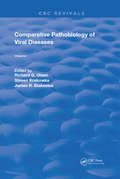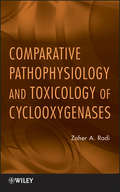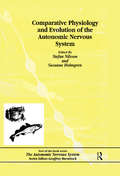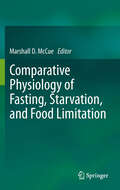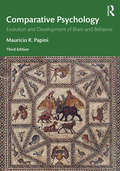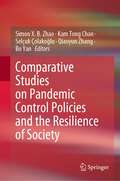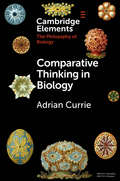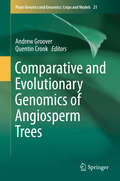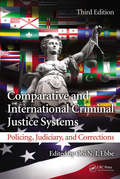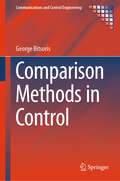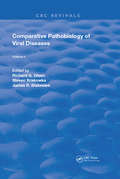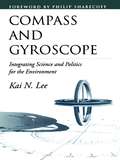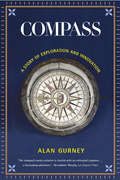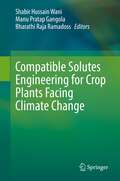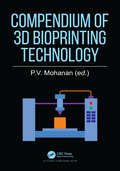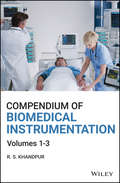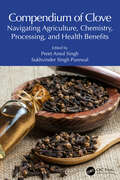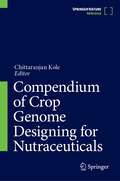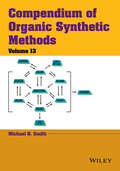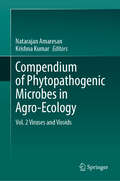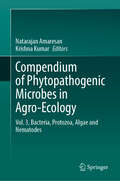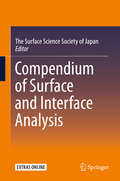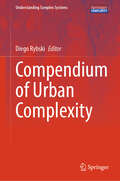- Table View
- List View
Comparative Pathobiology of Viral Diseases (Routledge Revivals #1)
by Richard G. Olsen Steven Krakowka James R. BlakesleeFirst Published in 1985, this book offers a full insight into the differences and similarities between varying diseases. Carefully compiled and filled with a vast repertoire of notes, diagrams, and references this book serves as a useful reference for students of medicine and other practitioners in their respective fields.
Comparative Pathophysiology and Toxicology of Cyclooxygenases
by Zaher A. RadiThe first thorough review of cyclooxygenase inhibitors, including their toxicity mechanisms and toxicopathological risks Cyclooxygenases (COXs) are enzymes responsible for the formation of an important class of biological mediators called prostanoids. Prostanoids such as prostaglandins mediate inflammatory and anaphylactic reactions. For those suffering from inflammation and pain, the pharmacological inhibition of COXs, with non-steroidal anti-inflammatory drugs (NSAIDs), such as ibuprofen, can provide relief. Yet the use of NSAIDs can trigger toxicological effects as well, leading to potential health risks. Comparative Pathophysiology and Toxicology of Cyclooxygenases provides a comprehensive overview of how COX inhibitors affect various bodily systems, specifically the toxicity mechanisms triggered when the COX enzyme is inhibited. The book provides an introduction to the discovery of cyclooxygenases, their use as therapeutic agents, as well as an historical perspective. Shedding light on the differences in expression, pathophysiology, and toxicology of COX inhibitors across species, the book offers a systematic examination of the effects and pathophysiology of COX inhibitors and their mechanisms of toxicity, beginning with the GI tract. Subsequent chapters cover: The pathophysiology of COX inhibition on bone, tendon, and ligament healing COX inhibitors and renal system pathophysiology and mechanisms of toxicity The pathophysiologic role of COX inhibition in the ocular system COX inhibition and the respiratory and cardiovascular systems The book also sheds light on the latest research devoted to developing COX inhibitors with no adverse side-effects. The first book to offer a thorough comparative look at the toxicological effects of COX inhibitors throughout the body, this invaluable resource will help advance the research and development of safer and more effective COX drugs.
Comparative Physiology and Evolution of the Autonomic Nervous System
by Charlotte B. NilssonComparative Physiology and Evolution of the Autonomic Nervous System, the fourth volume in the Autonomic Nervous System series, is an up-to-date account of the comparative physiology and functional anatomy of the autonomic nervous system, with an emphasis on non-mammalian vertebrates. The book starts with an overview of the field and then discusses both 'classical' (adrenergic and cholinergic) non-adrenergic and non-cholinergic (NANC) types of neurotransmission. The account is then further developed by an examination of the autonomic nervous control of specific systems and organs. Readership: Researchers, working professionals, undergraduates and graduates working in neurology, cardiology, internal medicine, clinical pharmacology, and hypertension.
Comparative Physiology of Fasting, Starvation, and Food Limitation
by Marshall D. MccueAll animals face the possibility of food limitation and ultimately starvation-induced mortality. This book summarizes state of the art of starvation biology from the ecological causes of food limitation to the physiological and evolutionary consequences of prolonged fasting. It is written for an audience with an understanding of general principles in animal physiology, yet offers a level of analysis and interpretation that will engage seasoned scientists. Each chapter is written by active researchers in the field of comparative physiology and draws on the primary literature of starvation both in nature and the laboratory. The chapters are organized among broad taxonomic categories, such as protists, arthropods, fishes, reptiles, birds, and flying, aquatic, and terrestrial mammals including humans; particularly well-studied animal models, e.g. endotherms are further organized by experimental approaches, such as analyses of blood metabolites, stable isotopes, thermobiology, and modeling of body composition.
Comparative Psychology: Evolution and Development of Brain and Behavior, 3rd Edition
by Mauricio R PapiniThis revised third edition provides an up to date, comprehensive overview of the field of comparative psychology, integrating both evolutionary and developmental studies of brain and behavior. This book provides a unique combination of areas normally covered independently to satisfy the requirements of comparative psychology courses. Papini ensures thorough coverage of topics like the fundamentals of neural function, the cognitive and associative capacities of animals, the development of the central nervous system and behavior, and the fossil record of animals including human ancestors. This text includes many examples drawn from the study of human behavior, highlighting general and basic principles that apply broadly to the animal kingdom. New topics introduced in this edition include genetics, epigenetics, neurobiological, and cognitive advances made in recent years into this evolutionary-developmental framework. An essential textbook for upper level undergraduate and graduate courses in comparative psychology, animal behavior, and evolutionary psychology, developmental psychology, neuroscience and behavioral biology.
Comparative Studies on Pandemic Control Policies and the Resilience of Society
by Simon X. B. Zhao Kam Tong Chan Selçuk Çolakoğlu Qiaoyun Zhang Bo YanThis book documents and analyses the differentiated control policies, the determinant factors behind, social resilience, and international relations during the pandemic from a comparative perspective in a facts-based, data-supporting manner. The intermittent outbreak of cases, public sentiments after long anxiety, questions over the efficacy of vaccines, have forced governments as well as the public to rethink differing approaches and policies in the combat against not just COVID, but the delta variant. In this context, this book establishes itself as a timely product, perhaps the first of its kind, to provide a widely covered individual country-based observation of policies, with an emphasis on multidimensional determinant factors behind the policies. A comparative study of social resilience during the pandemic constitutes another highlight of the book. The different policies tested social resilience differently in parameters such as mortality rates, vaccination coverage, social mobility, travel arrangements, trust in government, and general human development. Above and beyond observations and analyses at local and national levels, this book expands its scope to incorporate international relations, contemplating over the impacts of the pandemic on international relations, power shifts, and new world/global orders, crystallized in the indisputable rise of China.
Comparative Thinking in Biology (Elements in the Philosophy of Biology)
by Adrian CurrieBiologists often study living systems in light of their having evolved, of their being the products of various processes of heredity, adaptation, ancestry, and so on. In their investigations, then, biologists think comparatively: they situate lineages into models of those evolutionary processes, comparing their targets with ancestral relatives and with analogous evolutionary outcomes. This element characterizes this mode of investigation - 'comparative thinking' - and puts it to work in understanding why biological science takes the shape it does. Importantly, comparative thinking is local: what we can do with knowledge of a lineage is limited by the evolutionary processes into which it fits. In light of this analysis, the Element examines the experimental study of animal cognition, and macroevolutionary investigation of the 'shape of life', demonstrating the importance of comparative thinking in understanding both the power and limitations of biological knowledge.
Comparative and Evolutionary Genomics of Angiosperm Trees (Plant Genetics and Genomics: Crops and Models #21)
by Andrew Groover Quentin CronkMarking the change in focus of tree genomics from single species to comparative approaches, this book covers biological, genomic, and evolutionary aspects of angiosperm trees that provide information and perspectives to support researchers broadening the focus of their research. The diversity of angiosperm trees in morphology, anatomy, physiology and biochemistry has been described and cataloged by various scientific disciplines, but the molecular, genetic, and evolutionary mechanisms underlying this diversity have only recently been explored. Excitingly, advances in genomic and sequencing technologies are ushering a new era of research broadly termed comparative genomics, which simultaneously exploits and describes the evolutionary origins and genetic regulation of traits of interest. Within tree genomics, this research is already underway, as the number of complete genome sequences available for angiosperm trees is increasing at an impressive pace and the number of species for which RNAseq data are available is rapidly expanding. Because they are extensively covered by other literature and are rapidly changing, technical and computational approaches--such as the latest sequencing technologies--are not a main focus of this book. Instead, this comprehensive volume provides a valuable, broader view of tree genomics whose relevance will outlive the particulars of current-day technical approaches. The first section of the book discusses background on the evolution and diversification of angiosperm trees, as well as offers description of the salient features and diversity of the unique physiology and wood anatomy of angiosperm trees. The second section explores the two most advanced model angiosperm tree species (poplars and eucalypts) as well as species that are soon to emerge as new models. The third section describes the structural features and evolutionary histories of angiosperm tree genomes, followed by a fourth section focusing on the genomics of traits of biological, ecological, and economic interest. In summary, this book is a timely and well-referenced foundational resource for the forest tree community looking to embrace comparative approaches for the study of angiosperm trees.
Comparative and International Criminal Justice Systems: Policing, Judiciary, and Corrections, Third Edition
by Dale JuneComparative and International Criminal Justice Systems: Policing, Judiciary, and Corrections, Third Edition examines the history, dynamics, structure, organization, and processes in the criminal justice systems in a number of selected countries. Designed for courses in comparative criminal justice systems, comparative criminology, and international
Comparison Methods in Control (Communications and Control Engineering)
by George BitsorisThis book presents the theoretical foundations of the comparison approach and demonstrates how this method can be used for the development of techniques for the analysis and design of control systems in the state-space domain. It provides a framework for using the comparison approach to solve fundamental analysis and design problems of control systems, including invariance and contractivity, stability analysis and constrained control. Within this framework, the book shows the reader that the invariance of sets represented by sublevel subsets, the control-invariant regions, the stability properties and the design of constrained controllers for both continuous-time and discrete-time systems can be investigated using comparison systems. The dual approach of analysis and design, based on the representation of state-space regions in terms of a number of generators and a generating function, is developed. Polyhedral invariant sets, polyhedral control invariance, stability analysis using polyhedral Lyapunov functions and constrained control under linear constraints are also investigated. Comparison Methods in Control begins with an introduction and discusses stability, Lyapunov theory, and representation of connected sets. The book progresses through comparison in different contexts, such as comparison and invariance, comparison and stability, dual comparison systems and control invariance. Constrained regulation problems and constrained control of disturbed and parameter uncertain systems are all given equal attention. Researchers and postgraduate students with backgrounds in systems analysis, control and applied mathematics will find this monograph of interest.
Comparitive Pathobiology of Viral Diseases: Volume 2 (Routledge Revivals #2)
by Richard G. Olsen Steven Krakowka James R. BlakesleeFirst Published in 1985, this book offers a full insight into the differences and similarities between varying diseases. Carefully compiled and filled with a vast repertoire of notes, diagrams, and references this book serves as a useful reference for students of medicine and other practitioners in their respective fields.
Compass and Gyroscope: Integrating Science And Politics For The Environment
by Philip Shabecoff Kai N. LeeUsing the Columbia River Basin in the Pacific Northwest as a case study, Kai Lee describes the concept and practice of "adaptive management," as he examines the successes and failures of past and present management experiences. Throughout the book, the author delves deeply into the theoretical framework behind the real-world experience, exploring how theories of science, politics, and cognitive psychology can be integrated into environmental management plans to increase their effectiveness.
Compass: A Story of Exploration and Innovation
by Alan Gurney"The compass' rocky evolution is charted with an enthusiast's passion....A fascinating adventure."--Bernadette Murphy, Los Angeles Times Compass chronicles the misadventures of those who attempted to perfect the magnetic compass--so precious to sixteenth-century seamen that, by law, any man found tampering with it had his hand pinned to the mast with a dagger. From the time man first took to the seas until only one thousand years ago, sight and winds were the sailor's only navigational aids. It was not until the development of the compass that maps and charts could be used with any accuracy--even so, it would be hundreds of years and thousands of shipwrecks before the marvelous instrument was perfected. And its history up to modern times is filled with the stories of disasters that befell sailors who misused it. In this page-turning history of man's search for reliable navigation of treacherous sea routes around the globe, Alan Gurney brings to life the instrument Victor Hugo called "the soul of the ship."
Compatible Solutes Engineering for Crop Plants Facing Climate Change
by Shabir Hussain Wani Manu Pratap Gangola Bharathi Raja RamadossPlants, being sessile and autotrophic in nature, must cope with challenging environmental aberrations and therefore have evolved various responsive or defensive mechanisms including stress sensing mechanisms, antioxidant system, signaling pathways, secondary metabolites biosynthesis, and other defensive pathways among which accumulation of osmolytes or osmo-protectants is an important phenomenon. Osmolytes with organic chemical nature termed as compatible solutes are highly soluble compounds with no net charge at physiological pH and nontoxic at higher concentrations to plant cells. Compatible solutes in plants involve compounds like proline, glycine betaine, polyamines, trehalose, raffinose family oligosaccharides, fructans, gamma aminobutyric acid (GABA), and sugar alcohols playing structural, physiological, biochemical, and signaling roles during normal plant growth and development. The current and sustaining problems of climate change and increasing world population has challenged global food security. To feed more than 9 billion, the estimated population by 2050, the yield of major crops needs to be increased 1.1–1.3% per year, which is mainly restricted by the yield ceiling. A major factor limiting the crop yield is the changing global environmental conditions which includes drought, salinity and extreme temperatures and are responsible for a reduction of crop yield in almost all the crop plants. This condition may worsen with a decrease in agricultural land or the loss of potential crop yields by 70%. Therefore, it is a challenging task for agricultural scientists to develop tolerant/resistant varieties against abiotic stresses. The development of stress tolerant plant varieties through conventional breeding is very slow due to complex multigene traits. Engineering compatible solutes biosynthesis by deciphering the mechanism behind the abiotic tolerance or accumulation in plants cell is a potential emerging strategy to mitigate adverse effects of abiotic stresses and increase global crop production. However, detailed information on compatible solutes, including their sensing/signaling, biosynthesis, regulatory components, underlying biochemical mechanisms, crosstalk with other signaling pathways, and transgenic development have not been compiled into a single resource. Our book intends to fill this unmet need, with insight from recent advances in compatible solutes research on agriculturally important crop plants.
Compendium of 3D Bioprinting Technology
by P. V. Mohanan3D bioprinting is an emerging innovative technology that involves the fabrication of essential 3D functional biomedical constructs by combining cells and biomaterials with vital growth and differentiation factors. It aims to replicate the natural tissue milieu and holds great promise in fields like tissue engineering, regenerative medicine, drug development and testing, precision medicine, etc. 3D bioprinted disease-specific models help to study, screen the treatment methods and understand the mechanism of action. In personalized medicine, patient-specific tissue and organ constructs can be developed for specific surgeries and treatments tailored to a patient’s unique anatomy and genetics. 3D functional tissue construct addresses the problem of organ shortage as it lowers the risk of rejection of tissues and organs. The technique also replaces the need to experiment on animals and improves the accuracy of pre-clinical studies to test the safety and efficacy of new drugs in bioprinted tissues.This book provides comprehensive coverage of the application of 3D bioprinting technology. It is a collection of contributions by experts with cutting-edge know-how. The book is meant for medical practitioners, pharma companies, CROs, product developers, students, researchers, academicians, policymakers and practitioners.
Compendium of Biomedical Instrumentation
by Raghbir Singh KhandpurThe field of medical instrumentation is inter-disciplinary, having interest groups both in medical and engineering professions. The number of professionals associated directly with the medical instrumentation field is increasing rapidly due to intensive penetration of medical instruments in the health care sector. In addition, the necessity and desire to know about how instruments work is increasingly apparent. Most dictionaries/encyclopedias do not illustrate properly the details of the bio-medical instruments which can add to the knowledge base of the person on those instruments. Often, the technical terms are not covered in the dictionaries. Unless there is a seamless integration of the physiological bases and engineering principles underlying the working of a wide variety of medical instruments in a publication, the curiosity of the reader will not be satisfied. The purpose of this book is to provide an essential reference which can be used both by the engineering as well as medical communities to understand the technology and applications of a wide range of medical instruments. The book is so designed that each medical instrument/ technology will be assigned one or two pages, and approximately 450 medical instruments are referenced in this edition.
Compendium of Biophysics
by Andrey B. RubinFollowing up on his first book, Fundementals of Biophysics, the author, a well-known scientist in this area, builds on that foundation by offering the biologist or scientist an advanced, comprehensive coverage of biophysics. Structuring the book into four major parts, he thoroughly covers the biophysics of complex systems, such as the kinetics and thermodynamic processes of biological systems, in the first part. The second part is dedicated to molecular biophysics, such as biopolymers and proteins, and the third part is on the biophysics of membrane processes. The final part is on photobiological processes. This ambitious work is a must-have for the veteran biologist, scientist, or chemist working in this field, and for the novice or student, who is interested in learning about biophysics. It is an emerging field, becoming increasingly more important, the more we learn about and develop the science. No library on biophysics is complete without this text and its precursor, both available from Wiley-Scrivener.
Compendium of Clove: Navigating Agriculture, Chemistry, Processing, and Health Benefits
by Sukhvinder Singh Purewal Preet Amol SinghWelcome to the definitive guide Compendium of Clove: Navigating Agriculture, Chemistry, Processing, and Health Benefits, where centuries of tradition meet cutting-edge research on clove. Clove (Syzygium aromaticum) has a rich history dating back millennia, revered for its aromatic allure, medicinal properties, and economic significance across cultures. From the verdant plantations to the laboratory bench, each chapter in this book unfolds the intricate story of clove, bridging historical insights with contemporary studies, exploring its historical and botanical descriptions, community benefits, chemical composition, and diverse industrial applications.This A-Z compendium not only consolidates existing knowledge but also pioneers new frontiers in clove research. It offers a panoramic view that caters to botanists, pharmacognosists, phytochemists, pharmacologists, food scientists, agriculturalists, industrialists, and policymakers alike.KEY FEATURES: The book offers the origins and history of clove distribution, plant habits, and botanical descriptions. It provides insights into cultivation practices of clove, including good agricultural practices (GAP) and post-harvest management of clove. The book underlines how the biochemistry of plants, complete phytochemical screening, characterization, separation, and other factors affect the volatile oils of plants. It underlines clove's pharmacological and clinical aspects and highlights its usage in the food, pharmaceutical, and cosmetics industries. The book showcases market value, trade, and regulatory guidelines of clove in different countries. Whether you seek a botanical expedition or a pharmacological breakthrough, whether your interest lies in chemistry or global economics, this book embarks on a journey that celebrates clove as not just a spice but a cornerstone of interdisciplinary research and industrial enterprise. Join us as we unearth the essence of clove—a testament to nature's bounty and human ingenuity, encapsulated within the pages of this definitive document.
Compendium of Crop Genome Designing for Nutraceuticals
by Chittaranjan KoleThe crop plants cater not only to our basic F5 (food, feed, fiber, fuel, and furniture) needs but also provide a number of nutraceuticals with potential nutritional, safety and therapeutic properties. Many crop plants provide an array of minerals, vitamins, and antioxidant-rich bioactive phytochemicals. Increasing incidences of chronic diseases such as cancer, diabetes and HIV, and malnutrition necessitate global attention to health and nutrition security with equal emphasis to food security. This compendium compiles results of researches on biochemical, physiological and genetic mechanisms underlying biosynthesis of the health and nutrition related nutraceuticals. It also explores the precise breeding strategies for augmentation of their content and amelioration of their quality in crop plants under all commodity categories including cereals and millets, oilseeds, pulses, fruits and nuts, and vegetables. The compendium comprise 5 sections dedicated to these 5 commodity groups and presents enumeration on the concepts, strategies, tools and techniques of nutraceutomics. These sections include 50 chapters devoted to even number of major crop plants. These chapters present deliberations on the biochemistry and medicinal properties of the nutracuticals contained; genetic variation in their contents; classical genetics and breeding for their quantitative and qualitative improvement; tissue culture and genetic engineering for augmentation of productivity and quality; and sources of genes underlying their biosynthesis. They also include comprehensive enumeration on genetic mapping of the genes and QTLs controlling the contents and profile of the nutraceuticals and molecular breeding for their further improvement through marker assisted selection and backcross breeding tools. Prospects of post-genomic precise breeding strategies including genome-wide association mapping, genomic selection, allele mining, and genome editing are also discussed. This compendium fills the gap in academia, and research and development wings of the private sector industries interested in an array of subjects including genetics, genomics, tissue culture, genetic engineering, molecular breeding, genomics-assisted breeding, bioinformatics, biochemistry, physiology, pathology, entomology, pharmacognosy, IPR, etc., and will also facilitate understanding of the policy making agencies and people in the socio-economic domain and research sponsoring agencies.
Compendium of Organic Synthetic Methods
by Michael B. SmithThe Compendium of Organic Synthetic Methods serves as a handy desktop reference for organic chemists to browse new reactions and transformations of interest, facilitating the search for functional group transformations in the original literature of organic chemistry. Volume 13 contains both functional group transformations and carbon-carbon bond forming reactions from the literature in the years 2005-8. It presents examples of published reactions for the preparation of monofunctional compounds. The Compendium of Organic Synthetic Methods series facilitates the search for quality, selected functional group transformations, organized by reacting functional group of starting material and functional group formed, with full references to each reaction Presents examples of published reactions for the preparation of monofunctional compounds from the literature of 2005-8 Provides a handy reference and a valuable tool to the working organic chemist, allowing a quick check of known organic transformations Stringent criteria for inclusion of reactions, including real synthetic utility of reactions, reagents readily available or easily prepared and handled in the laboratory
Compendium of Phytopathogenic Microbes in Agro-Ecology : Vol. 2 Viruses and Viroids
by Krishna Kumar Natarajan AmaresanThis book offers an in-depth exploration of phytopathogenic viruses and viroids within the context of agroecology. Each chapter meticulously details the introduction, taxonomy, and diseases caused by these pathogens, alongside their pathogenic mechanisms, economic significance, and strategies for identification and control. By providing comprehensive insights into these topics, the book empowers researchers to manipulate these pathogens to suit their needs. The chapters investigate key concepts such as pathogen taxonomy, disease cycles, and control measures, addressing critical questions about their economic impact on crop yield. Expert contributors present a thorough analysis of 104 plant pathogens, organized into distinct microbial groups. This volume is an essential resource for understanding the complex interactions between pathogens and their host plants, offering practical solutions for disease management. This book is an invaluable resource for postgraduate students, research scholars, post-doctoral fellows, and educators across disciplines such as Plant Microbiology, Plant Pathology, Entomology, Virology, and Nematology. As the second volume in a comprehensive three-part series, it provides crucial insights into the economic importance of bacteria, fungi, viruses, viroids, and nematodes. This compendium is a must-have for anyone seeking to deepen their understanding of plant pathogens and their impact on agriculture.
Compendium of Phytopathogenic Microbes in Agro-Ecology : Vol. 3, Bacteria, Protozoa, Algae and Nematodes
by Krishna Kumar Natarajan AmaresanThis book offers an in-depth exploration of phytopathogenic bacteria, nematodes, protozoa, and algae within the context of agroecology. Each chapter meticulously details the introduction, taxonomy, and diseases caused by these pathogens, alongside their pathogenic mechanisms, economic significance, and strategies for identification and control. By providing comprehensive insights into these topics, the book empowers researchers to manipulate these pathogens to suit their needs. Key concepts covered include the economic impact of plant pathogens on yield loss, the pathogenic cycles of various microbes, and effective control measures. The book's expert contributors present a thorough analysis of 104 plant pathogens, organized into distinct microbial groups. This volume is an essential resource for understanding the complex interactions between pathogens and their host plants, offering valuable knowledge for developing sustainable agricultural practices. This book is an indispensable resource for postgraduate students, research scholars, post-doctoral fellows, and educators in fields such as Plant Microbiology, Plant Pathology, Bacteriology, Protozoology, Algology, and Nematology. As the second volume in a comprehensive three-volume compendium, it provides critical insights into the economic importance of pathogens and their role in yield loss, making it a must-have for anyone involved in plant sciences.
Compendium of Phytopathogenic Microbes in Agro-Ecology : Vol.1 Fungi
by Krishna Kumar Natarajan AmaresanThis book offers an in-depth exploration of phytopathogenic fungi within the context of agroecology, providing essential insights for understanding and managing these critical organisms. Each chapter begins with a comprehensive information panel that introduces the pathogen, detailing its taxonomy, the diseases it causes, its pathogenic mechanisms, economic significance, and strategies for identification and control. By equipping researchers with this knowledge, the book empowers them to manipulate these fungi to meet their specific needs. Key concepts covered include the taxonomy and life cycles of various fungi, the economic impact of fungal diseases on crop yield, and innovative control measures. The book's expert contributors provide a thorough analysis of each pathogen, making it an indispensable resource for anyone involved in plant health and disease management. This volume is the first in a three-part series that will cover a total of 104 plant pathogens, including bacteria, viruses, viroids, and nematodes, highlighting their economic importance in agriculture. This book is an invaluable resource for postgraduate students, research scholars, post-doctoral fellows, and educators in fields such as Plant Microbiology, Plant Pathology, Entomology, Virology, and Nematology. It is a must-read for those seeking to deepen their understanding of plant pathogens and their impact on agriculture.
Compendium of Surface and Interface Analysis
by The Surface Science Society of JapanThis book concisely illustrates the techniques of major surface analysis and their applications to a few key examples.Surfaces play crucial roles in various interfacial processes, and their electronic/geometric structures rule the physical/chemical properties. In the last several decades, various techniques for surface analysis have been developed in conjunction with advances in optics, electronics, and quantum beams. This book provides a useful resource for a wide range of scientists and engineers from students to professionals in understanding the main points of each technique, such as principles, capabilities and requirements, at a glance. It is a contemporary encyclopedia for selecting the appropriate method depending on the reader's purpose.
Compendium of Urban Complexity (Understanding Complex Systems)
by Diego RybskiThis book brings together key findings, insights, and theories at the intersection of two disciplines – city science and complex systems. It features a curated collection of chapters contributed by emerging scholars conducting cutting-edge research in complexity science, interdisciplinary physics, and quantitative geography. The compendium is tailored to a thematically diverse audience, spanning quantitative fields such as statistical and mathematical physics, as well as socially-focused domains such as geography and urban planning. By integrating novel methods and insights from physics, economics, and geography, this book aims at an interdisciplinary spectrum of graduate students and academic researchers studying cities as complex systems.
